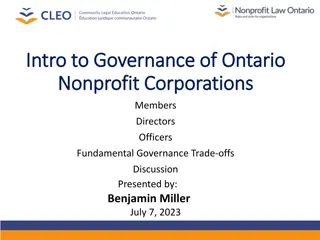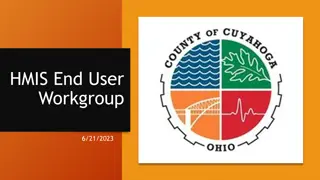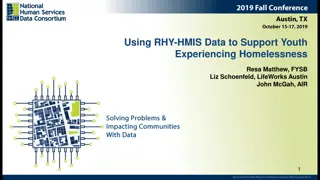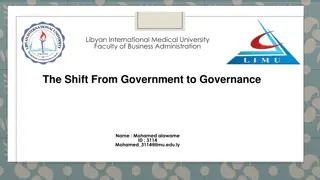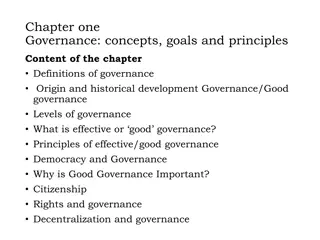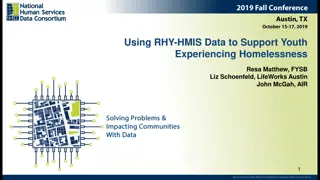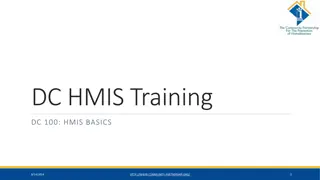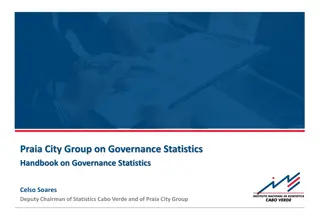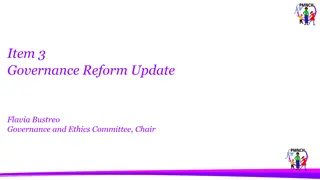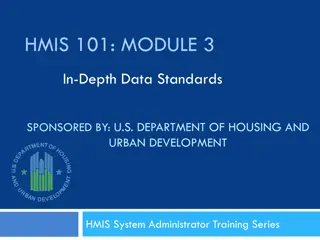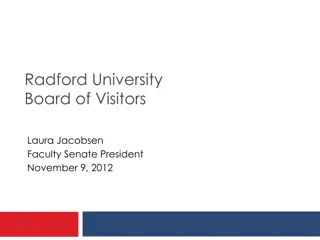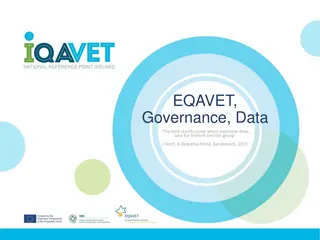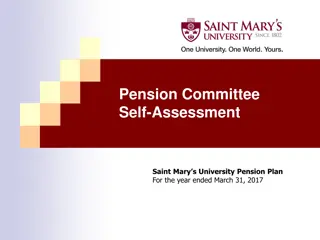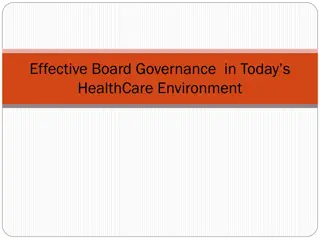Enhancing HMIS Governance and Management for Stakeholders
Explore best practices in HMIS administration, governance, and management to improve core competencies related to policy development, monitoring, and end-user support. Strengthen collaboration and accountability among HMIS stakeholders, designate HMIS leads, ensure compliance with HUD requirements, and manage HMIS responsibilities effectively. Additionally, handle hosting and maintenance of HMIS software, data warehousing, training, and resource allocation to support HMIS operations and enhancements.
Download Presentation

Please find below an Image/Link to download the presentation.
The content on the website is provided AS IS for your information and personal use only. It may not be sold, licensed, or shared on other websites without obtaining consent from the author.If you encounter any issues during the download, it is possible that the publisher has removed the file from their server.
You are allowed to download the files provided on this website for personal or commercial use, subject to the condition that they are used lawfully. All files are the property of their respective owners.
The content on the website is provided AS IS for your information and personal use only. It may not be sold, licensed, or shared on other websites without obtaining consent from the author.
E N D
Presentation Transcript
Review requirements of HMIS administration and operation by HMIS stakeholders Present national best practices on HMIS governance and management Provide attendees with approaches to improving core competencies related to policy development, monitoring, and end user support Explore ways to strengthen collaboration and accountability across HMIS stakeholders
Designate the HMIS Designate the HMIS Lead Approve privacy, security, and data quality plans Develop HMIS policies and procedures (and update annually) Ensure consistent participation in HMIS Ensure that HMIS is administered in compliance with HUD requirements
Responsible for managing the HMIS for the CoC s geographic area, in accordance with the CoC Program interim rule and any HMIS requirements prescribed by HUD Additional responsibilities assigned to the HMIS Lead by the CoC Additional responsibilities identified in annual NOFAs
Hosting and maintaining HMIS software or data; Backing up, recovering, or repairing HMIS software or data; Upgrading, customizing, and enhancing the HMIS; Integrating and warehousing data, including development of a data warehouse for use in aggregating data from subrecipients using multiple software systems; Administering the system; Reporting to providers, the Continuum of Care, and HUD; and Conducting training on using the system, including traveling to the training.
Purchasing or leasing computer hardware; Purchasing software or software licenses; Purchasing or leasing equipment Obtaining technical support; Leasing office space and paying charges for electricity, gas, water, phone service, and internet services Travel costs for conferences and to conduct intake Paying HMIS participation fees Paying salaries for operating HMIS
Experience and national examples identifies several additional areas: Monitoring and oversight (privacy, security, and data quality plans) Governance, management, and collaboration with the CoC Policy development and implementation System administration and operation Training development and delivery Data analysis/reporting Help desk operation and end user support
How do you as HMIS Leads and Sys Admins spend most of your time? Monitoring and oversight Governance, management, and collaboration with the CoC Policy development System administration Training Data analysis/reporting Help desk operation Text answer to (Mentimeter poll forthcoming)
Based on your CoCs priorities, on what topic should you be spending more of your time? Monitoring and oversight Governance, management, and collaboration with the CoC Policy development System administration Training Data analysis/reporting Help desk operation Text answer to (Mentimeter poll forthcoming)
Experience and national examples identifies several additional areas: Monitoring and oversight (privacy, security, and data quality plans) Governance, management, and collaboration with the CoC Policy development and implementation System administration and operation Training development and delivery Data analysis/reporting Help desk operation and end user support
Monitoring HMIS stakeholders is crucial to ensure ongoing compliance and performance End user monitoring: Review audit trails and user logs to ensure appropriate system use Privacy and security compliance Monitoring log-in frequency to support timely data entry Agency monitoring: License allocation and use Data quality
Monitoring HMIS stakeholders is crucial to ensure ongoing compliance and performance Vendor monitoring: Contractual terms and conditions Functions and features Report accuracy and HMIS compliance CoC HMIS monitoring: HMIS Lead performance Funding and diversity of sources Training delivery Report submission (timeliness and accuracy)
Governance impacts how an HMIS Lead operates within a CoC s structure Structure HMIS CoC Governance Policy Process Performance
Governance Structure or Model Defining organizational roles and responsibilities Developing accountability mechanisms Establishing linkages between organizations/entities Governance of Policy Defining who has the authority to develop, review, and approve policies and procedures
Governance of Process Establishing the process of engaging in policy development and decision-making forums Backed up by charters, by-laws, and other process documents Governance of Performance Developing standardized monitoring and evaluation Ensuring transparency and accountability
Problem: CoCs participate in an informal statewide or regional HMIS implementation, but only one CoC develops P&Ps or provides leadership Solutions: Assess funding structures across CoCs Identify policy practice feedback loops Develop formal governance structure, based on statewide/regional vision for HMIS Align ideal P&Ps with intended outcomes
Problem: Providers not receiving HUD funding do not participate in the CoC s HMIS Solutions: Survey non-participating providers to determine primary reason for non-participation Create incentives to increase participation (improved workflow, subsidized license fees, enhanced reporting capacity, etc.) Support data exchange or HMIS build-out to decrease duplicate data entry
Problem: Data quality monitoring findings are not utilized Solutions: Identify particular challenges of data quality Diagnose underlying cause of DQ issue Insufficient licenses, lack of incentives, staff turnover, HMIS workflow, etc. Work with CoC to develop stronger incentives and/or sanctions for data quality issues Adopt implementation cycles to include continuous DQ monitoring through report cards or checklists
Problem: The CoC requests frequent and complex ad hoc reports to inform planning and policy Solutions: Develop a data dashboard with live and standardized metrics Create regular data uploads of data for ad hoc queries Identify common ad hoc report parameters and develop a standardized report
Alissa Parrish, Institute for Community Alliances CoC HMIS Lead communication Developing a vision for data use Implementing DQ improvement process
Some of the emerging priorities of HMIS Leads include: Data quality management and improvement Vendor monitoring and oversight Policy and procedure development or enhancement Data literacy and availability Setting policy and improving practice is a continuous cycle
Plan Do Study Act: Plan: Identify challenges and develop a plan for progress Do: Develop and implement strategies to achieve goals Study: Assess and track progress according to pre-defined measures Act: Make changes to the next round of improvement Policy practice feedback loop integrates feedback from the field (participating agencies) to policy decisions (set by the CoC) to inform how policy affects outcomes.
Some of the most important work of HMIS Leads is not required by regulations Successful HMIS Leads are objective, transparent, and collaborative Developing specific performance measures are crucial for contract management and performance monitoring
Success requires investment from all stakeholders CoC leadership: link data quality and HMIS performance to funding decisions and coordinated entry design HMIS Lead: provide DQ reports and system-wide analyses to stakeholders, and support capacity building and training activities HMIS vendor: respond to CoC s needs and provide enhanced reporting and analyses tools Participating agencies: implement DQ standards and staff capacity to support ongoing HMIS success
What is your next immediate step to improve how the HMIS Lead works within your CoC? Review current P&Ps and update as needed Monitor participating agencies Review vendor contracts and agency participation agreements Connect with your peers and brush up on best practices Develop new training material based on HUD guidance and national best practices Text answer to (Mentimeter poll forthcoming)
Ryan Burger ryan.burger@icf.com Mike Lindsay michael.lindsay@icf.com



